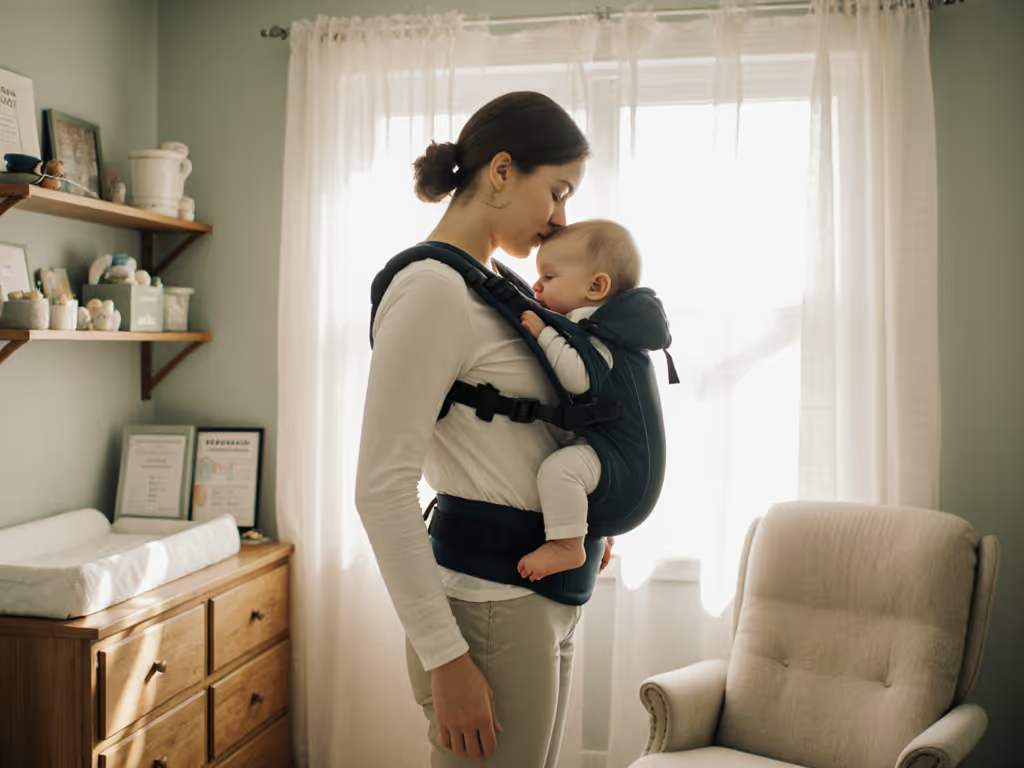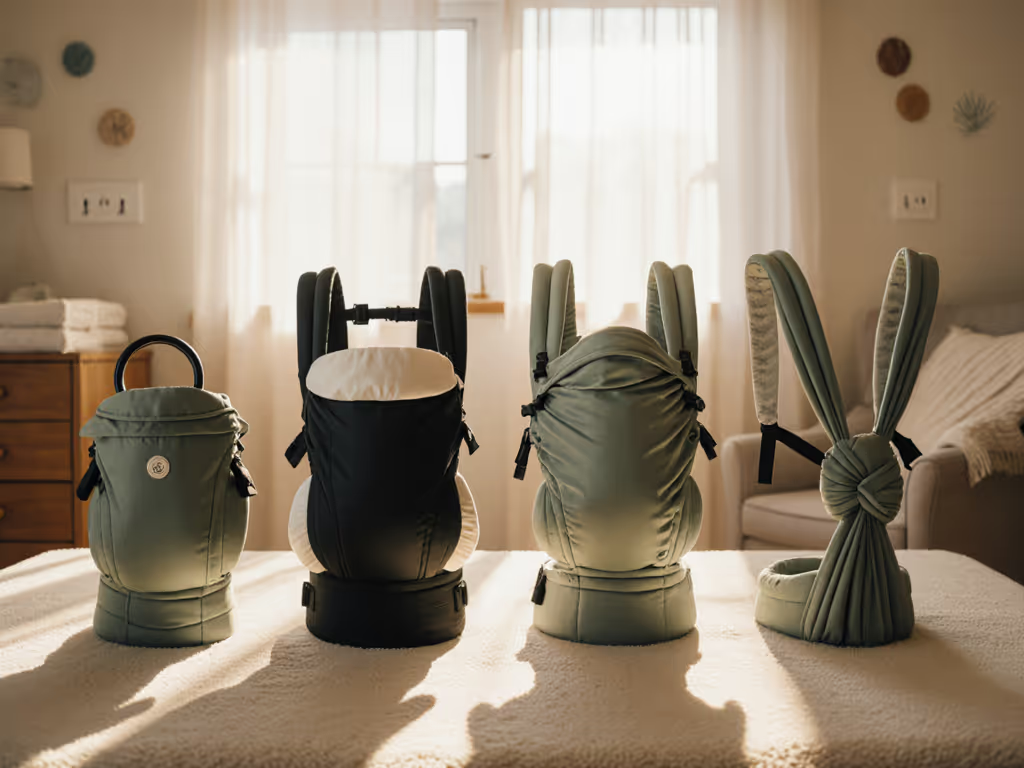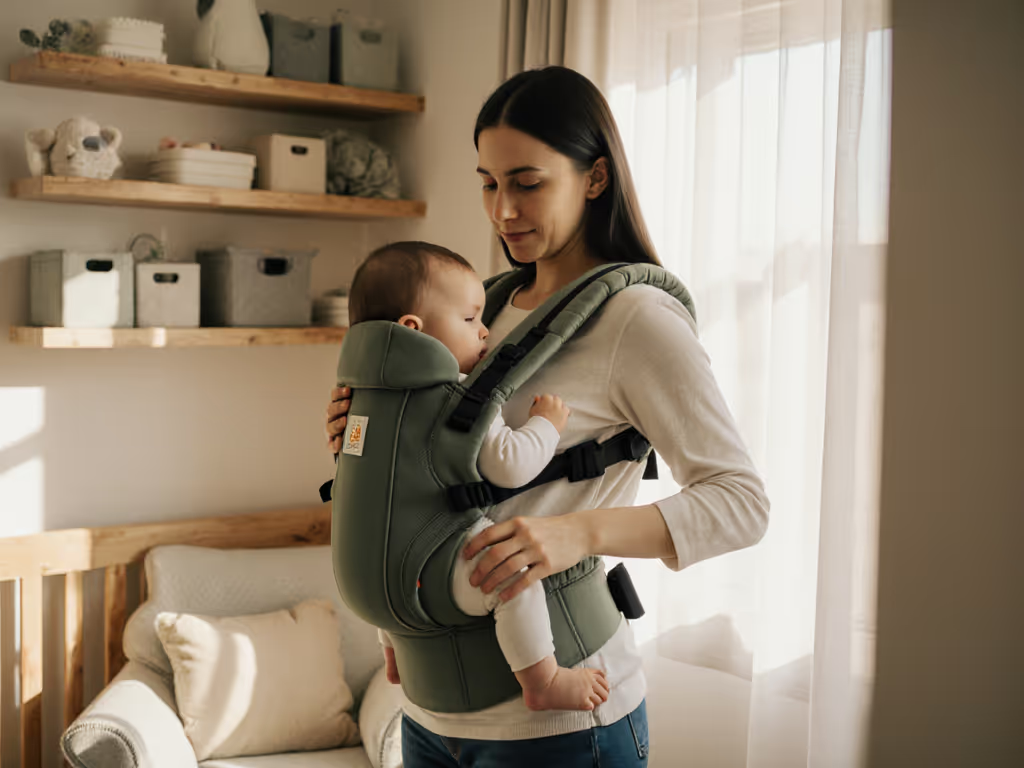
7 Examples of Safe Babywearing Every Caregiver Should Know

Did you know that up to 95 percent of parents say babywearing makes daily life easier? The way you carry your baby has a direct impact on their comfort, safety, and development, whether you prefer structured carriers, wraps, or slings. By understanding different carrying techniques and supports, you can help your baby grow strong and secure while staying comfortable yourself.
Quick Summary
| Takeaway | Explanation |
|---|---|
| 1. Use structured carriers for full support | Structured carriers provide even weight distribution and support your baby's developing body. |
| 2. Focus on proper newborn positioning in wraps | Ensure your newborn is high enough to kiss and their face is unobstructed for safe breathing. |
| 3. Master hip carrying techniques for toddlers | Proper weight distribution and arm positioning prevent strain while keeping your toddler secure and engaged. |
| 4. Regularly check airway and chin placement | Always maintain a clear breathing space to prevent airway compression and ensure safety. |
| 5. Adjust carrier fit for individual body types | Personalized adjustments help distribute weight evenly and improve comfort during babywearing. |
1. Using a Structured Carrier for Full Body Support
When it comes to babywearing, a structured carrier represents the gold standard for keeping your little one safe and comfortable. These carriers provide critical support across your baby's entire body, distributing weight evenly and maintaining proper alignment from head to hip.
Structured carriers excel at protecting your infant's developing musculoskeletal system by promoting natural positioning. Unlike makeshift carrying methods, these specialized carriers have intentional design features that support your baby's spine, neck, and hip development. A well-designed structured carrier mimics the natural way an infant would be held in arms while providing hands-free convenience for caregivers.
What makes structured carriers so beneficial? They feature strategic elements like padded shoulder straps, adjustable width settings, and ergonomic seat designs that cradle your baby's body. These design aspects matter significantly for newborns and infants who cannot yet support their own head or maintain proper body positioning.
When selecting a structured carrier, look for these key characteristics:
- Adequate head and neck support for younger infants
- Wide, supportive seat that keeps hips in a "M" position
- Adjustable straps that distribute weight across your shoulders
- Breathable materials that prevent overheating
- Easily washable fabric for practical maintenance
Pro Tip: Always check the weight and age recommendations for your specific carrier. Most structured carriers work best for babies between 7 and 25 pounds, with specific design variations for different developmental stages.
By investing in a high quality structured carrier, you provide your baby with a secure environment that supports healthy physical development while giving yourself the freedom to move and multitask. The right carrier becomes an extension of your parenting approach focused on comfort, safety, and connection.
2. Proper Positioning with a Soft Wrap for Newborns
Newborn babywearing requires exceptional care and attention to detail, with soft wraps emerging as an incredible solution for providing intimate and secure carrying experiences. These fabric wraps create a womb-like environment that helps newborns feel safe while supporting their delicate physical development.
Newborn positioning is far more complex than many parents realize. Soft wraps allow you to create a customized carrying space that mimics the natural curves and support of human arms. The stretchy fabric conforms to your baby's body, providing crucial support for their developing spine, neck, and hip muscles.
The secret to successful soft wrap wearing lies in understanding proper vertical positioning. Your newborn should be positioned high on your chest, with their head close enough to kiss. This positioning ensures optimal airway protection and enables you to monitor your baby's breathing and comfort continuously.
When wrapping your newborn, focus on these critical elements:
- Ensure baby's face remains visible and unobstructed
- Position baby's legs in a natural "frog" or "M" position
- Keep baby's head supported and chin off their chest
- Maintain a snug but not overly tight wrap configuration
- Check that fabric supports baby's entire back and bottom
Warning: Always perform the "kiss test" by tilting your head down. If you can easily kiss the top of your baby's head, your wrap positioning is likely correct. If you cannot see or access your baby's face, readjust immediately.
Mastering soft wrap techniques takes practice. Start in front of a mirror, move slowly, and prioritize your baby's comfort and safety. With patience and attention, you will create a nurturing carrying environment that promotes bonding and supports your newborn's physical development.
3. Hip Carry Techniques for Toddlers and Older Babies
As your baby grows more active and curious, hip carrying becomes an essential skill for modern caregivers. This technique allows you to keep your little one close while maintaining freedom of movement and providing a sense of security for both parent and child.
Hip carrying represents more than just a convenient way to transport your baby. It supports your child's physical and emotional development by keeping them engaged with their environment while feeling protected. Unlike infant carrying methods, hip carries work best for babies who can independently hold their head up and have strong core muscle control.
The key to successful hip carrying lies in understanding proper weight distribution and body mechanics. Your baby should sit comfortably on your strongest side, with their legs straddling your hip and their body weight supported by a combination of carrier design and your arm positioning. This approach prevents strain on your back and ensures your baby feels secure and comfortable.
When implementing a hip carry, consider these critical guidelines:
- Choose a carrier with sturdy side support
- Position baby high enough to see over your shoulder
- Ensure baby's legs are spread in a natural "M" configuration
- Keep one hand free to provide additional support if needed
- Rotate carrying sides to prevent muscle imbalance
Pro Tip: Practice hip carries in front of a mirror initially to understand proper alignment. Start with shorter durations and gradually increase carrying time as both you and your baby become more comfortable with the technique.
Remember that every child is different. Some toddlers will love hip carries immediately, while others might need gradual introduction. Pay attention to your baby's cues and comfort level, adjusting your approach accordingly. With patience and practice, hip carrying can become an intuitive and enjoyable way to stay connected with your growing child.
4. Using a Ring Sling for Quick and Safe Wearing
Ring slings represent the ultimate solution for parents seeking a flexible and rapid babywearing method that combines convenience with intimate connection. These lightweight carriers offer unprecedented versatility for caregivers who need to quickly transition between holding and hands-free activities.
Efficient positioning is the hallmark of successful ring sling use. Unlike more complex carrier systems, ring slings allow for immediate adjustment and quick placement of your baby in multiple carrying positions. The fabric threads through two specialized rings, creating a secure and adjustable carrying environment that can be modified in seconds.
The magic of ring slings lies in their adaptability. They work beautifully for newborns through toddler stages, supporting everything from nursing positions to upright carries. The key is understanding how to thread and tighten the rings to create a secure pouch that supports your baby's entire body weight while maintaining proper spinal alignment.
Master ring sling techniques by focusing on these critical elements:
- Create a deep seated pocket for optimal baby support
- Spread fabric wide across your back to distribute weight
- Keep baby high enough to easily kiss the top of their head
- Ensure fabric covers baby from knee to knee
- Regularly adjust and check sling tension
Warning: Always perform the "safety scoop" by supporting your baby with one hand while adjusting the ring sling. Never rely solely on the fabric until you have completed a full, secure adjustment.
Practice makes perfect with ring slings. Start by watching tutorial videos, practicing near a bed or soft surface, and taking your time to understand the nuanced adjustments. With patience, you will transform this simple piece of fabric into an incredibly versatile parenting tool that keeps your baby close and your hands free.
5. Checking Airway and Chin Placement for Breathing Safety
Breathing safety represents the most critical aspect of responsible babywearing. Proper airway positioning can mean the difference between a secure carrying experience and a potentially dangerous situation for your infant.
Airway protection requires continuous vigilance and understanding of your baby's anatomical vulnerabilities. Newborns and young infants cannot independently adjust their head position, which means caregivers must carefully monitor their breathing space and neck alignment. The primary risk involves potential airway compression that could restrict oxygen flow.
The "two finger" rule becomes your essential safety benchmark. You should always be able to fit two fingers between your baby's chin and chest. This simple check ensures that their airway remains open and unobstructed. When your baby's chin falls too closely to their chest, it can create a dangerous breathing restriction that might not be immediately apparent.
Keep these critical safety guidelines in mind:
- Position baby high enough to easily kiss their head
- Maintain a clear breathing space around the nose and mouth
- Avoid fabric covering the baby's face
- Ensure neck can move slightly from side to side
- Check breathing rhythm periodically
Warning: If you notice any signs of labored breathing such as grunting, nostril flaring, or unusual color changes, immediately reposition your baby and consult medical professionals.
Remember that each baby carrier requires specific positioning techniques. What works perfectly in a structured carrier might need adjustment in a wrap or sling. Developing muscle memory for safe positioning takes practice. Start by practicing near a mirror, move slowly, and prioritize your baby's comfort and respiratory safety above all else.
6. Supporting Baby's Hips and Spine in Every Carry
Your baby's physical development depends critically on proper musculoskeletal support during carrying. Understanding how to protect their delicate spine and hip joints is essential for preventing potential long term developmental challenges.
Ergonomic positioning serves as the cornerstone of safe babywearing. Babies require carriers that mimic their natural physiological alignment, supporting the natural "M" or "frog" leg position that prevents hip dysplasia and promotes healthy joint development. This means creating a seated position where your baby's knees are higher than their bottom, creating a wide based support that distributes weight evenly.
The wrong carrying technique can place unnecessary stress on your baby's developing skeletal system. Carriers that force legs into a straight or dangling position can potentially create unnecessary joint strain. Instead, look for carriers that allow your baby's natural curved spine to maintain its organic shape while providing full thigh and bottom support.
When selecting and using a carrier, focus on these critical elements:
- Ensure carrier creates a deep seated position
- Support baby's thighs from knee to knee
- Maintain a slight natural curve in the spine
- Allow free movement of hips and legs
- Check that weight is distributed evenly
Pro Tip: The ideal carrier will create a position similar to how you would naturally hold a baby in your arms. If the carrier feels uncomfortable or forces an unnatural posture, it likely needs adjustment.
Remember that your baby's body is constantly developing. What works perfectly at two months might require modification at six months. Stay attentive, regularly reassess your carrying technique, and do not hesitate to consult pediatric professionals if you have specific concerns about your baby's physical development.
7. Adjusting Carrier Fit for Different Body Types
Babywearing is not a one-size-fits-all experience. Every caregiver has a unique body type, and understanding how to customize your carrier ensures both comfort and safety for you and your baby.
Personalized fitting transforms babywearing from a challenging task to an enjoyable bonding experience. Carriers need strategic adjustments based on your height, weight, shoulder width, and torso length. What works perfectly for a tall person might create significant discomfort for someone with a shorter frame.
The key to successful carrier adaptation lies in understanding your body's specific ergonomic needs. Shoulder straps should distribute weight evenly without creating pressure points. Waistbands need precise positioning to prevent lower back strain. Some carriers offer multiple adjustment points specifically designed to accommodate diverse body types and physiques.
Consider these critical fitting strategies:
- Adjust shoulder straps to sit comfortably without digging
- Position waistband at natural waist level
- Ensure even weight distribution across back and shoulders
- Check for potential fabric bunching or twisting
- Allow enough room for natural movement
Pro Tip: If possible, try carriers with a friend or partner who can help assess fit from behind. What feels comfortable to you might look differently from an external perspective.
Remember that carrier comfort evolves. Your body changes postpartum, and your carrying technique will improve with practice. Do not get discouraged if the first few attempts feel awkward. Patience and willingness to make incremental adjustments will help you discover the perfect carrying method for your unique body.
Below is a comprehensive table summarizing the key babywearing techniques and considerations discussed in the article.
| Technique | Description | Key Considerations |
|---|---|---|
| Structured Carrier | Provides full body support and maintains alignment from head to hip. | Adequate head/neck support, wide seat, breathable materials. |
| Soft Wrap | Creates a womb-like environment for newborns. | Proper vertical positioning, "frog" leg position, snug wrap. |
| Hip Carry | Allows active toddlers to stay engaged while being carried. | Use sturdy side support, alternate sides, maintain "M" leg position. |
| Ring Sling | Offers quick and flexible carrying solutions. | Quick adjustment, deep pocket for support, ensure proper spinal alignment. |
| Breathing Safety | Ensures secure airway protection during carrying. | Keep baby high, visible face, perform "two finger" rule for airway check. |
| Ergonomic Support | Supports healthy hip and spine development. | Ensure "M" position, distribute weight evenly, allow natural spine curve. |
| Carrier Fit | Adjust carrier for different caregiver body types. | Customize straps and waistband for comfort, prevent pressure points. |
Turn Knowledge Into Confidence With Safer Babywearing Now
Learning about safe babywearing is just the beginning. If you have ever felt unsure about choosing the right carrier, worried about hip support, or struggled to master the proper airway positioning, you are not alone. The article highlighted the importance of full body support, proper newborn positioning, and critical safety checks like chin placement to keep your baby safe—these topics reflect the real challenges caregivers face every day.
Take your next step towards safe, confident babywearing with Caregiver Carry. Explore our detailed safety checklists, visual positioning guides, and up-to-date carrier reviews. You can find clear answers to your questions and proven advice tailored to your child’s age, your body type, and your lifestyle. Ready for peace of mind? Visit Caregiver Carry now and start protecting your baby’s well-being with every carry.
Frequently Asked Questions
What does proper positioning in babywearing look like?
Proper positioning in babywearing means ensuring your baby's head is close enough to kiss, while their legs are in a natural 'M' shape. Focus on elevating your baby high on your chest for improved safety and comfort.
How can I ensure airway safety for my baby while babywearing?
To ensure airway safety, always check that you can fit two fingers between your baby's chin and chest, which helps keep their airway open. Regularly monitor your baby's breathing space to make adjustments as necessary and keep fabric away from their face.
What features should I look for in a structured carrier?
When selecting a structured carrier, look for features like adequate head and neck support, a wide supportive seat for hip positioning, and padded, adjustable straps. Prioritize carriers that provide breathable materials to help prevent overheating.
How do I properly adjust a ring sling for safety and comfort?
To adjust a ring sling, create a deep pocket for optimal baby support, and ensure the fabric covers baby from knee to knee. Regularly check the sling tension and avoid relying on the fabric until adjustments are fully secured.
What techniques can I use for hip carrying my toddler?
For hip carrying, ensure your toddler sits comfortably on your strong side, with their legs straddling your hip. Keep their body weight distributed evenly and practice rotating sides to prevent muscle imbalance while monitoring their comfort.
How can I adapt my carrier fit for my unique body type?
To adapt your carrier for your body type, adjust shoulder straps for even weight distribution and position the waistband at your natural waist level. Regularly reassess fit and comfort as your body changes postpartum or as carrying techniques improve.



